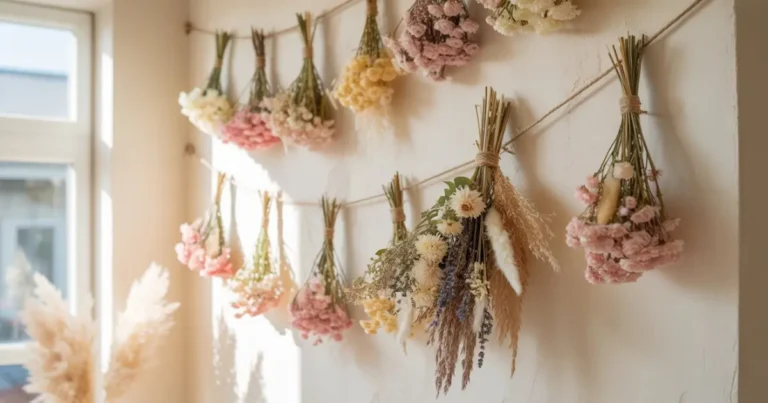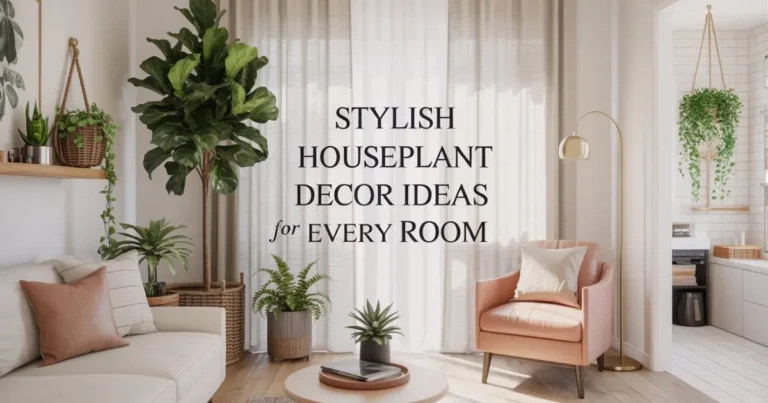10 Mistakes to Avoid When Decorating with Dried Flowers
Table of Contents
A Bloom That Never Dies—But It Can Still Go Wrong
You’ve likely seen them—those enchanting, everlasting bouquets perched on Pinterest-worthy shelves or nestled inside rustic vases on farmhouse tables. Dried flowers hold an undeniable charm: they’re natural, low-maintenance, and long-lasting. But as simple as they seem, decorating with dried flowers is an art that can easily go awry if you’re not careful.
Maybe you’ve brought home a bunch of beautiful dried lavender, only to find it looking limp and colorless within weeks. Or perhaps your latest arrangement feels more like an outdated relic than a cozy statement piece. Don’t worry—you’re not alone.
This guide will help you avoid the most common mistakes people make when using dried flowers in decor, so your arrangements look effortlessly elegant instead of unintentionally awkward.
Let’s make your space bloom the right way. And to help you get started easily, you can find all the dried flowers, vases, sealants, and DIY supplies mentioned in this guide available for purchase on Amazon — just check them out here and bring your floral vision to life with just a few clicks!
1. Choosing the Wrong Flowers for Drying
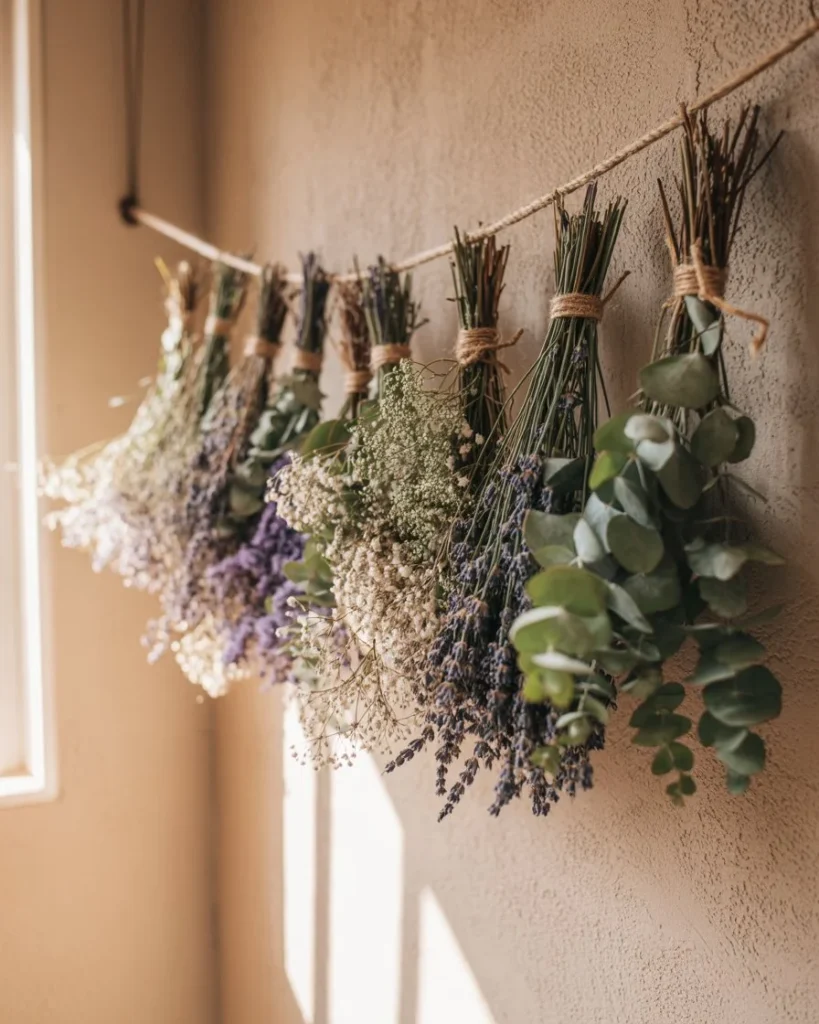
Not every bloom is destined for a second life.
Some flowers may look stunning when fresh but don’t hold up once dried. Their petals fall apart, their colors fade rapidly, or they collapse under their own weight.
What You Should Use:
Stick to flowers known for their structural integrity and color retention. Here’s a quick-reference table:
| Flower | Best Drying Method | Lasts | Color Quality |
|---|---|---|---|
| Lavender | Air dry, upside down | 1+ year | Excellent |
| Baby’s Breath | Air dry | 6–12 months | Great |
| Statice | Hang drying | 12+ months | Very good |
| Eucalyptus | Air dry or glycerin | 1+ year | Good |
| Hydrangeas | Silica gel | 1–2 years | Fair to good |
Flowers to Avoid:
- Tulips
- Peonies
- Daisies
- Calla lilies
These tend to wilt quickly or lose their charm once dried.
2. Skipping the Drying Process or Doing It Wrong
You might be tempted to just let your bouquet sit out and “naturally dry.” But that’s a recipe for sagging petals, mold, or total color loss.

Proper Drying Techniques:
- Air Drying: The most popular and easiest. Bundle stems and hang them upside down in a dark, dry area.
- Silica Gel Drying: Ideal for keeping color and form
- Microwave Drying: Fast but riskier. Only for small, durable blooms.
- Pressing: Ideal for flat arrangements or frames.
Always start drying while flowers are still fresh and firm—not after they’ve begun to wilt.
3. Ignoring the Power of a Sealant
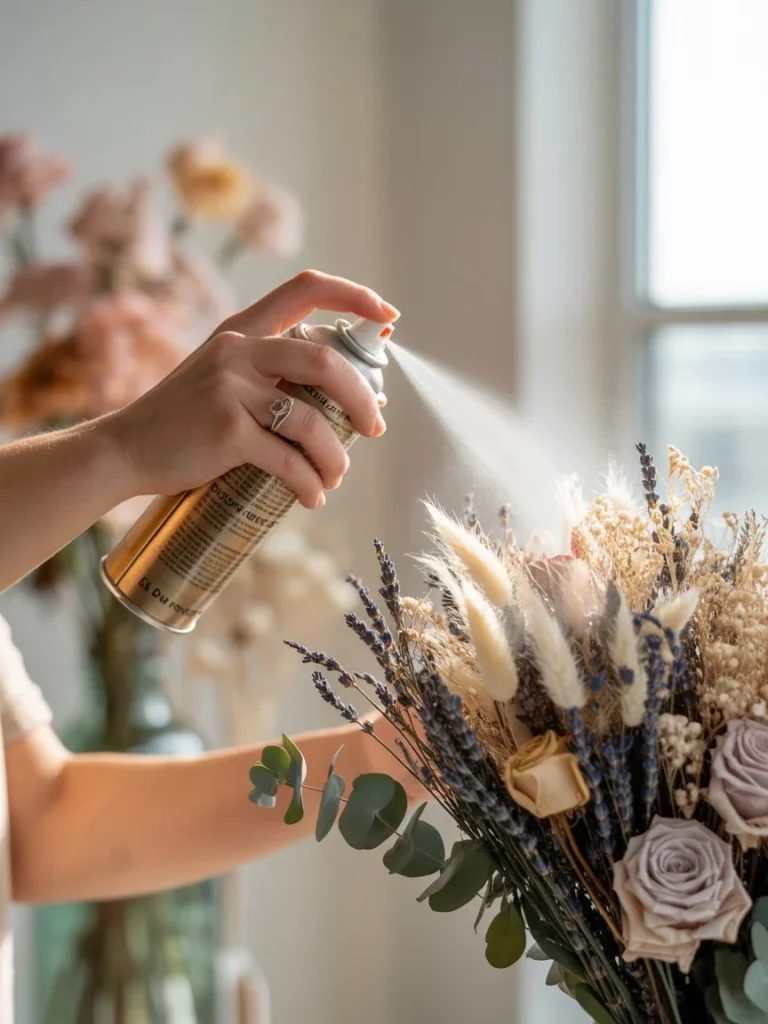
This one’s easy to overlook but can make all the difference.
Dried flowers are delicate. Over time, they shed petals, release dust, and lose their appeal. A simple fix? Use a fixative spray.
What Works:
- Floral sealant (available at most craft stores)
- Unscented hairspray (a good alternative in a pinch)
Application Tips:
- Hold 12–15 inches away
- Light, even coats
- Allow full drying between sprays
This protective barrier helps retain color, shape, and strength.
4. Placing Your Flowers in Direct Sunlight
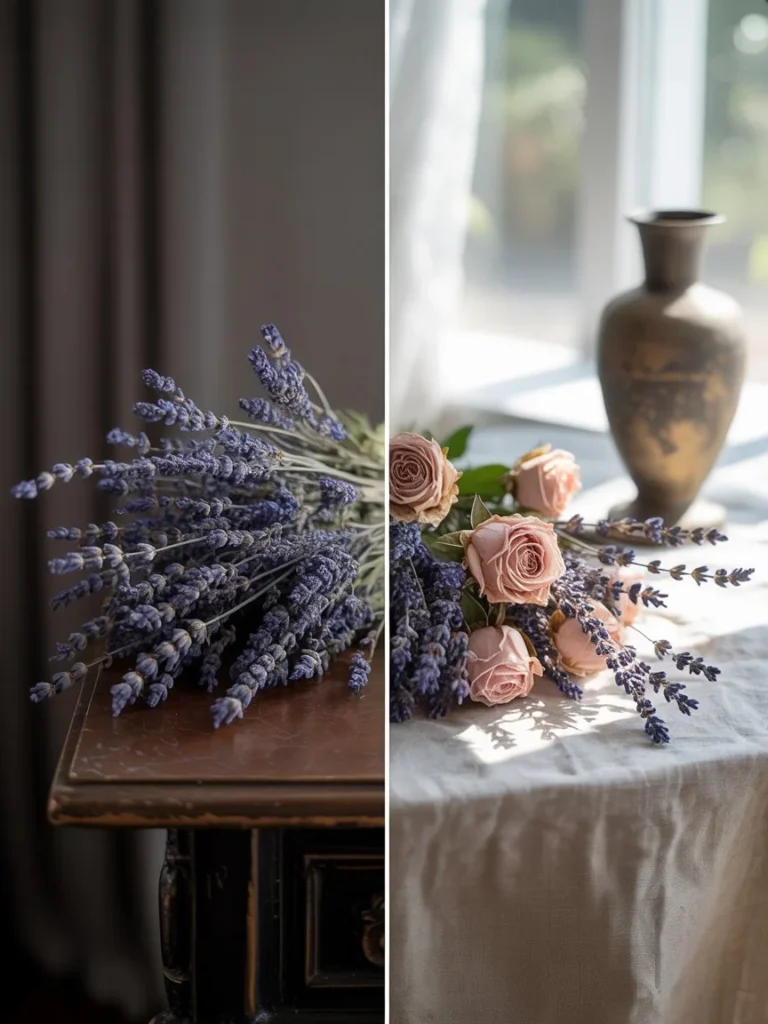
Dried flowers are like vampires—they hate the sun. When you’re decorating with dried flowers, placing your bouquet near a window might feel right, but UV rays will bleach out their colors fast. What once was a soft pink will turn yellow or brown within weeks.
Best Spots to Display:
- On shaded bookshelves
- Inside glass domes
- High up on mantels, away from direct light
- On coffee tables under light-filtering shades
If you must place them near sunlight, consider using UV-filtering film on your windows or display them in UV-protected glass cases.
5. Forgetting to Clean Them

Here’s something few talk about: dried flowers tend to attract dust.
Because they’re static and fragile, they accumulate dust easily—and cleaning them the wrong way can destroy them.
Gentle Cleaning Methods:
- Compressed air: Use on the lowest setting.
- Soft paintbrush: Gently dust each bloom.
- Hair dryer (cool setting): Blow from a distance of at least 12 inches.
Avoid using wet cloths or wipes—they’ll damage the petals instantly.
6. Picking the Wrong Container or Vase
When you place dried flowers in the wrong vessel, you disrupt the whole aesthetic.
Avoid:
- Heavy, tall glass vases with narrow mouths
- Metal containers (can rust or discolor the stems)
- Vases with water left in them (yes, it happens!)
What Works Best:
- Ceramic vases with wide openings
- Rustic wooden boxes for horizontal arrangements
- Woven baskets for boho charm
- Mason jars for farmhouse looks
Choose a container that complements the room and stabilizes your stems.
7. Overcrowding the Arrangement
Too many stems = no room to breathe.
Cluttered arrangements overwhelm the eye. Dried flowers need airiness and space between them to shine.
Tips for Layout:
- Use odd numbers (3, 5, 7 stems) for balance
- Vary height and volume
- Don’t mix more than 3 main textures
- Let focal flowers stand out—don’t bury them
Think of it as a conversation. You don’t want every flower shouting at once.
8. Clashing Colors and TexturesThrowing random flowers together rarely results in harmony.
Instead, follow these guidelines:
Color Pairings:
- Soft neutrals + dried greens = earthy calm
- Pastels + whites = cottagecore elegance
- Deep burgundies + rust tones = cozy autumnal mood
Texture Matching:
- Pair feathery (pampas, wheat) with structured (statice, eucalyptus)
- Avoid pairing all fragile or all stiff flowers—it creates imbalance
Use a neutral backdrop to let the arrangement pop.
9. Letting Them Decay Without Refreshing
Even dried flowers have a shelf life.
Yes, they last longer than fresh ones, but not forever. Over time, petals will fade, crumble, and discolor.
How to Keep Things Fresh:
- Replace stems every 6–12 months
- Rotate in seasonal flowers (e.g., sunflowers in summer, pine in winter)
- Add new elements like dried herbs or faux stems to update the look
This habit keeps your decor from feeling stale.
10. Ignoring Scent or Ambience
Dried flowers don’t usually carry their original scent—and that can leave your display feeling flat.
What You Can Do:
- Add a few drops of essential oils to the stems (lavender, orange, sandalwood)
- Include dried herbs or fragrant woods (like rosemary or cedar)
- Place a nearby diffuser or potpourri bowl for extra aroma
Make the visual and sensory experience work together.
Bonus DIY Recipe: Scented Potpourri Mix for Dried Arrangements
| Ingredient | Amount | Purpose |
|---|---|---|
| Dried rose petals | 1 cup | Base fragrance |
| Dried lavender | ½ cup | Relaxation scent |
| Cinnamon sticks | 2 whole | Warmth and spice |
| Dried orange peels | ¼ cup | Citrusy freshness |
| Cloves | 1 tbsp | Adds depth and earthiness |
| Essential oil (optional) | 10–15 drops | Boost scent (e.g., vanilla) |
Instructions:
- Mix ingredients in a bowl.
- Let sit overnight to infuse.
- Store in breathable sachets or sprinkle around arrangements.
FAQs About Decorating with Dried Flowers
How long do dried flowers last in home decor?
With the right care, dried flowers can last from 6 months to 2 years. Avoid sunlight and moisture for longer lifespan.
Can I mix dried and artificial flowers?
Absolutely. When done with care, combining dried and faux flowers can enhance texture and fullness.
What’s the best way to keep dried flowers from shedding?
Use a floral sealant spray. Light coats help maintain shape and minimize petal loss.
Do dried flowers attract insects or pests?
If fully dried and sealed, no. But keep them in dry, clean areas and avoid exposure to moisture.
Are dried flowers eco-friendly?
Yes! They reduce waste, last longer than fresh flowers, and don’t require water or refrigeration.
Let Your Style Bloom—Without the Fuss
Decorating with dried flowers is more than a trend—it’s a lifestyle choice that combines beauty, sustainability, and ease. When you avoid these common mistakes, your arrangements will do more than decorate your space—they’ll tell a story.
So now it’s your turn. Look at your current dried arrangements. Are they fading? Clashing? A little dusty?
Take action. Refresh your bouquet, rearrange that vase, or even start from scratch. You’ve got the tips—you just need to use them.
Additional FAQs:
What are the top mistakes to avoid when decorating with dried flowers?
Common mistakes include placing them in direct sunlight, overcrowding arrangements, skipping sealant sprays, and choosing flowers that don’t dry well. Avoiding these pitfalls ensures your decorating with dried flowers looks beautiful and lasts longer.
How can I make decorating with dried flowers more fragrant?
Since dried flowers often lose their natural scent, you can enhance your arrangements by adding essential oils or mixing in fragrant dried herbs like lavender or rosemary while decorating with dried flowers.
Can decorating with dried flowers suit modern home styles?
Definitely! Decorating with dried flowers can complement modern, rustic, or boho styles by selecting the right colors, textures, and containers to match your interior design.
✅ Call to Action:
Ready to master the art of dried flower decor?
🌿 Pin this guide, share it with a friend, and don’t forget to subscribe to our blog for weekly inspiration on natural home styling.
For more seasonal decor ideas, be sure to check out our detailed article on Business Christmas Decorations to add a festive touch to your space.
And if you’re proud of your bouquet—tag us on Instagram with #MyDriedStyle. We’d love to feature your beautiful creations!
Conclusion
Decorating with dried flowers offers a timeless, eco-friendly way to enhance your home’s atmosphere. By avoiding the top mistakes highlighted—such as choosing the wrong flowers, skipping proper drying, neglecting sealants, or exposing your blooms to sunlight—you’ll elevate your decorating with dried flowers to a professional level. Remember, decorating with dried flowers is not just about aesthetics but also about preserving their natural beauty and longevity. Follow these expert tips, and watch your space bloom beautifully with effortless charm.


